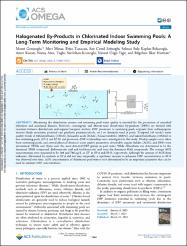Halogenated by-products in chlorinated indoor swimming pools: a long-term monitoring and empirical modeling study

Göster/
Erişim
info:eu-repo/semantics/openAccessTarih
2023Yazar
Genişoğlu, MesutMinaz, Mert
Tanacan, Ertaç
Sofuoğlu, Sait Cemil
Kaplan Bekaroğlu, Şehnaz Şule
Kanan, Amer
Ateş, Nuray
Sardohan Köseoğlu, Tuğba
Yiğit, Nevzat Özgü
Harman, Bilgehan İlker
Üst veri
Tüm öğe kaydını gösterKünye
Genisoglu, M., Minaz, M., Tanacan, E., Sofuoglu, S. C., Kaplan-Bekaroglu, S. S., Kanan, A., Ates, N., Sardohan-Koseoglu, T., Yigit, N. Ö., & Harman, B. I. (2023). Halogenated By-Products in Chlorinated Indoor Swimming Pools: A Long-Term Monitoring and Empirical Modeling Study. ACS omega, 8(12), 11364–11372. https://doi.org/10.1021/acsomega.3c00091Özet
Monitoring the disinfection process and swimming pool water quality is essential for the prevention of microbial infections and associated diseases. However, carcinogenic and chronic-toxic disinfection by-products (DBPs) are formed with reactions between disinfectants and organic/inorganic matters. DBP precursors in swimming pools originate from anthropogenic sources (body secretions, personal care products, pharmaceuticals, etc.) or chemicals used in pools. Temporal (48 weeks) water quality trends of trihalomethanes (THMs), haloacetic acids (HAAs), haloacetonitriles (HANs), and halonitromethanes (HNMs) in two swimming pools (SP-A and SP-B) and precursor-DBP relationships were investigated in this study. Weekly samples were taken from swimming pools, and several physical/chemical water quality parameters, absorbable organic halides (AOX), and DBPs were determined. THMs and HAAs were the most detected DBP groups in pool water. While chloroform was determined to be the dominant THM compound, dichloroacetic acid and trichloroacetic acid were the dominant HAA compounds. The average AOX concentrations were measured to be 304 and 746 mu g/L as Cl- in SP-A and SP-B, respectively. Although the amount of AOX from unknown chlorinated by-products in SP-A did not vary temporally, a significant increase in unknown DBP concentrations in SP-B was observed over time. AOX concentrations of chlorinated pool waters were determined to be an important parameter that can be used to estimate DBP concentrations.

















